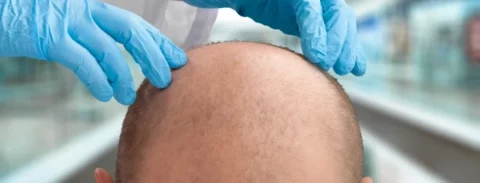Growth factor treatments are by far one of the most revolutionary ways to treat a variety of medical and cosmetic conditions. More commonly known as PRP or platelet-rich-plasma treatments, using growth factors has steadily risen in popularity with regenerative medicine for its versatility and results. But while the effects of growth factor treatments are well-documented with medical injuries, its use on more cosmetic concerns like hair regrowth isn’t that understood.
So what does growth factor treatment mean for hair rejuvenation? Broadly, it’s using the regenerative and reconstructive properties of your platelets to boost cell regrowth, helping restore your lost hair volume and improve the general health of your scalp. While initial results using PRP injections on the scalp have been proven promising for hair regrowth and regeneration, the exact results need more studies and research, like most cosmetic applications of PRP treatment.
What Is Growth Factor Treatment?
With growth factor treatments, a concentrated platelet solution is injected into your body to help repair tissue damage, promote cell regrowth, and speed up wound healing. Primarily using your body’s own healing mechanisms instead of surgery or medications, growth factor treatment is by far one of the most effective approaches in regenerative medicine.
The reason why growth factor treatment is so effective with its results is that it specifically relies on your body’s platelets. While normally dormant unless there’s active injury, your platelets get a kick-start for cell regrowth and regeneration response because of growth factor treatment.
By extracting a blood sample from the patient and processing it so only platelets remain, providers can inject a pure sample of platelet-rich plasma and growth factors directly into the area that needs treatment, which kick-starts the cell reconstruction process.
What Are The Advantages Of Using Growth Factor Treatment?

So now you have an understanding of how the process works, you may be wondering why you should go through with it? Here are a few advantages to using PRP treatments over other conventional treatments:
1) Versatile Approach
One of the most notable advantages of using growth factor therapy is that it’s a versatile treatment option: equally applicable for both cosmetic and medical purposes. Because platelets can generally help in building in almost every type of cell in any area of the body, the applications for growth factor therapy can be virtually endless – though it will depend on the skill of the provider and the type of PRP preparation used.
2) Non-Invasive Procedure
Unlike hair transplantation surgery or other hair loss treatments that are more on the invasive side, the process required for growth factor treatment only needs injections. No incisions are needed, which drastically reduces the pain and trauma your skin will have to endure during treatment. If you have sensitive skin, your provider can also provide anesthesia or topical numbing cream to lessen the pain.
3) Little to No Post-Procedure Downtime
Another benefit to only having injections involved in your growth factor therapy is that it puts less strain on your body to recover. Injections are by far some of the easiest procedures to recover from, especially when given some at-home care. You can easily continue on your usual routines and day-to-day activities shortly after the PRP injection and while specifics will depend on your provider’s advice, most patients can generally resume their normal activities after treatment.
4) Little Risk Of Treatment Rejection
Because the growth factors are processed from your own blood, PRP therapy has a low to non-existent rejection rate when it comes to actual treatment. Medical and cosmetic procedures have historically suffered from this issue, since the chemicals used may be too strong or incompatible with the body.Growth factor treatment, on the other hand, lets your growth factors work unhindered by your body’s own defense mechanisms and may give you better results in turn.
5) Simple Process
The process for acquiring the compounds needed for a PRP injection is relatively simple. All you need to do is to give a sample of your own blood, and your provider will do the rest. However, this does mean that you must pass a screening test to ensure that your body can handle the extraction process of the blood sample required, but most patients generally don’t have a problem with this procedure.
How Does It Interact With Hair?

So how exactly does growth factor treatment work for hair regrowth? Because platelets can increase the rate of wound healing in the body, they can work to restore damaged hair follicles and improve overall scalp health. PRP injections are applied directly to the scalp, so the platelets get to work more quickly than other treatments.
These PRP injections can be further boosted by adding different compounds to the growth factor product, like fibrin to make the cells stick together more efficiently. However, you should keep in mind that these options are limited to what your provider can give you – so make sure to check if their platelet-rich plasma treatments can be administered this way.
Aside from the platelets, the growth factors themselves also work to stimulate the production and increase of hair growth. Increasing the collagen production levels in the body, which are crucial to maintaining healthy hair or skin. By increasing these factors, providers can boost the effects of the already-potent growth factor treatment, though the exact results will drastically differ depending on the patient.
How Effective Is Growth Factor Treatment For Hair?
Despite the well-documented effects of growth factor therapy for medical purposes such as sports medicine, their effects on cosmetic concerns like hair regrowth and hair rejuvenation are less clear. But this is not to say that there haven’t been studies done on the matter – several studies in 2019 have seen some correlation between PRP injections and additional hair growth and improved hair density.
However, further studies need to be done to determine the exact efficacy of growth factor treatment. While all the evidence proves so far that PRP injections for hair regrowth are safe – which is also why the process is FDA-approved – it’s difficult to make exact claims about how well it works.
Part of this is because the exact PRP preparation process isn’t the same across providers, which causes a difference in the growth factors available for treatment. In fact, it’s these different standards that prove one of the biggest stumbling blocks to figuring out how effective the treatment is overall.
Despite the limited evidence, the earliest results from clinical trials and results from providers across the United States helped push PRP injections with growth factor treatment for FDA approval, and they’re now a staple treatment in many med spas and cosmetic practices for hair regrowth and rejuvenation.
Most patients usually report favorable results after a few treatments of growth factor therapy, with many taking it over more invasive options like hair transplantation surgery or topical hair regrowth products. Because the process for extracting, processing, and administering the growth factor treatment doesn’t take too much out of the patient, plenty of people choose it as an option if they don’t want to go through the usual methods.
Are There Other Options For Hair Regrowth?

But what are the other methods available for people who want to experience hair regrowth? Here are some of the most common therapies that your providers can administer/recommend:
1) Topical Medications
Using medications like minoxidil is by far one of the most common ways to restore lost hair and combat hair loss. Products like Rogaine are easily accessible and can be applied without the need for professional supervision.
However, the drawback behind using this method is that the strength of the solution can often have unexpected or adverse effects on the person using it, especially for women. Given that so many women also suffer from conditions like androgenetic alopecia, the potential side effects that they may get from using minoxidil and other similar solutions can end up causing their hair more harm than good.
2) Natural Remedies
For people who don’t want to risk the side effects of chemical formulations, natural remedies like essential oils can be a good substitute. Many ingredients like rosemary oil, peppermint oil, and aloe vera have long been used in traditional medicine and other folk cures, with varying success rates depending on the patient.
Keep in mind that natural remedies are often less reliable than chemical products, primarily because their ingredients aren’t potent enough to affect that significant of a change. This can be an issue for people who are looking for quick results or providers who don’t have access to more potent versions of these products.
3) Collagen Products
A byproduct of growth factor therapy is that it increases collagen production in the skin. This encourages hair follicle growth in turn and helps the patients get the results they want. Products like creams, serums, lotions, shampoos, and other similar topical applications can be applied to the skin to increase the amount of collagen available for the body to use.
By far, one of the most effective ways to bring back collagen to the system is by using an injectable collagen solution, though patients should be careful that the overall effects of this treatment still need further study. It’s also important to find the right provider that can offer this service.
4) Vitamin Supplements
Hair growth is controlled by many different compounds in the body, most of them derived from the food that you eat. If a specific vitamin is lacking from your diet or because of a pre-existing condition, then vitamin supplements can help replace the lost nutrients and ensure that your hair maintains its strength. With consistent and early treatment, it may be possible to reverse hair loss entirely.
Supplements may be effective, but keep in mind that you should clear the use of such supplements with your primary care doctor. Most of the nutrients that we need for growing healthy hair are already accessible from the food we eat, so make sure that you’re actually getting the supplements that you really need.
A mixture of two or more of these solutions may be enough to make a visible difference with hair growth and rejuvenation, but one thing that makes them extremely compatible with growth factor therapy and PRP injections is that they almost never interfere with each other’s effects. As a result, it’s entirely possible to still use growth factor treatment as a secondary method for hair rejuvenation.
FACE Med Store: Your Partner In Providing Medical Tools And Supplies
Growth factor treatments, especially the ones that involve some form of PRP therapy, have all shown some promise with rejuvenating hair. While the different processes for growth factor treatment have proven safe for use and have even been approved by the FDA, it’s also crucial to keep in mind that they require more studies before their effects are fully understood by the public. If you want to get growth factor treatment, just make sure you get quality products or find an experienced provider.
FACE Med Store is trusted by medical and cosmetic practices for quality and medical-grade tools and supplies at affordable prices. Combined with our long history of excellent customer service, we’ve made getting crucial medical tools and supplies easier for everyone across the United States. Whether it’s a cosmetic procedure in-clinic or skin rejuvenation treatments for use at home, we have the supplies you need to get it done.
For more information about us and our stocks, visit our website today.















